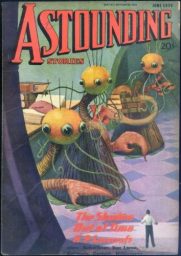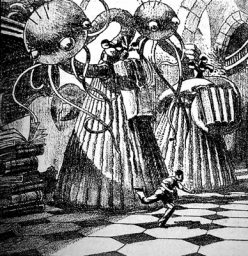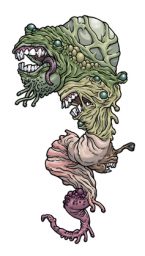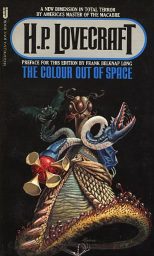The 2016 H. P. Lovecraft Re-read: The Shadow Out of Time
Sunday , 23, October 2016 Fiction, Short Fiction 11 Comments H. P. Lovecraft wrote “The Shadow Out of Time” in November-December 1934. It is a novella at 25,323 words. This is the other pillar of his cosmic history. There is a sense of déjà vu reading it as he reused some ideas.
H. P. Lovecraft wrote “The Shadow Out of Time” in November-December 1934. It is a novella at 25,323 words. This is the other pillar of his cosmic history. There is a sense of déjà vu reading it as he reused some ideas.
The main plot concerns Nathaniel Wingate Peaslee, an instructor of Political Economy at Miskatonic University. He has a collapse while teaching. When he awoke with amnesia that lasted from 1908 through 1913.
The new personality has a certain alien aspect with awkward speech. He spends time mastering history, science, art, language, and folklore. Peaslee at times would refer to specific events in dim ages outside the range of accepted history.
He associates with leaders of occultist groups and scholars. Mention is made of Comte d’Erlette’s Cultes des Goules, Ludvig Prinn’s De Vermis Mysteriis, Von Junt’s Unaussprchlichen Kulten, The Book of Eibon, and the Necronomicon.
In 1913, Peaslee built a mechanism that is a mixuture of rods, wheels, and mirrors. A “lean, dark, curiously foreign-looking man” calls at the house but is gone sometime in the early morning hours the next day. His doctor receives a long distance call for him to check on Peaslee. He finds Peaslee unconscious in a chair, gives him an injection. Later in the morning, the Peaslee wakes up giving the economics lecture he had been giving in 1908 when he collapsed.
Chapter II has Peaslee troubled by strange dreams of colossal stone cities and strange vegetation. Chapter III reveals another elder species, that Lovecraft with a lack of imagination called the Great Race. They lived until 50 million years ago in what became Australia. They are able to exchange minds throughout time.
The Great Race is described in Chapter IV:
“They seemed to be enormous iridescent cones, about ten feet high and ten feet wide at the base, and made up of some ridgy, scaly, semi-elastic matter. From their apexes projected four flexible, cylindrical members, each a foot thick, and of a ridgy substance like that of the cones themselves. These members were sometimes contracted almost to nothing, and sometimes extended to any distance up to about ten feet. Terminating two of them were enormous claws or nippers. At the end of a third were four red, trumpet-like appendages. The fourth terminated in an irregular yellowish globe some two feet in diameter and having three great dark eyes ranged along its central circumference. Surmounting this head were four slender grey stalks bearing flower-like appendages, whilst from its nether side dangled eight greenish antennae or tentacles. The great base of the central cone was fringed with a rubbery, grey substance which moved the whole entity through expansion and contraction.”

Chapter IV also contains the section that is always remembered by anyone who has read the story:
“There was a mind from the planet we know as Venus, which would live incalculable epochs to come, and one from an outer moon of Jupiter six million years in the past. Of earthly minds there were some from the winged, star-headed, half-vegetable race of palaeogean Antarctica; one from the reptile people of fabled Valusia; three from the furry pre-human Hyperborean worshippers of Tsathoggua; one from the wholly abominable Tcho-Tchos; two from the arachnid denizens of earth’s last age; five from the hardy coleopterous species immediately following mankind, to which the Great Race was some day to transfer its keenest minds en masse in the face of horrible peril; and several from different branches of humanity.
I talked with the mind of Yiang-Li, a philosopher from the cruel empire of Tsan-Chan, which is to come in A.D. 5000; with that of a general of the great-headed brown people who held South Africa in B.C. 50,000; with that of a twelfth-century Florentine monk named Bartolomeo Corsi; with that of a king of Lomar who had ruled that terrible polar land 100,000 years before the squat, yellow Inutos came from the west to engulf it; with that of Nug-Soth, a magician of the dark conquerors of A.D. 16,000; with that of a Roman named Titus Sempronius Blaesus, who had been a quaestor in Sulla’s time; with that of Khephnes, an Egyptian of the 14th Dynasty who told me the hideous secret of Nyarlathotep; with that of a priest of Atlantis’ middle kingdom; with that of a Suffolk gentleman of Cromwell’s day, James Woodville; with that of a court astronomer of pre-Inca Peru; with that of the Australian physicist Nevil Kingston-Brown, who will die in A.D. 2518; with that of an archimage of vanished Yhe in the Pacific; with that of Theodotides, a Graeco-Bactrian official of B.C. 200; with that of an aged Frenchman of Louis XIII’s time named Pierre-Louis Montmagny; with that of Crom-Ya, a Cimmerian chieftain of B.C. 15,000; and with so many others that my brain cannot hold the shocking secrets and dizzying marvels I learned from them.”
 Lovecraft names checks items from Robert E. Howard, Clark Ashton Smith, plus his own mythology of Lomar.
Lovecraft names checks items from Robert E. Howard, Clark Ashton Smith, plus his own mythology of Lomar.
There is the same info dump on the culture of the Great Race just like he did in At the Mountains of Madness. Just as the Old Ones had to contend with Shoggoths, the Great Race had to deal with the Elder Things. Lovecraft engages in vague word salad to describe the Elder Things:
“A horrible elder race of half-polypous, utterly alien entities which had come through space from immeasurably distant universes and had dominated the earth and three other solar planets about six hundred million years ago. They were only partly material—as we understand matter—and their type of consciousness and media
of perception differed wholly from those of terrestrial organisms. For example, their senses did not include that of sight; their mental world being a strange, non-visual pattern of impressions. They were, however, sufficiently material to use implements of normal matter when in cosmic areas containing it; and they required housing—albeit of a peculiar kind. Though their senses could penetrate all material barriers, their substance could not; and certain forms of electrical energy could wholly destroy them. They had the power of aërial motion despite the absence of wings or any other visible means of levitation. Their minds were of such texture that no exchange with them could be effected by the Great Race.”
Chapter V is a Miskatonic University expedition to Western Australia. Professor William Dyer, the geologist who narrated At the Mountains of Madness. They find the ruins of city of the Great Race. Chapter VII is an overwritten description of Peaslee exploring a subterranean passage in the city. He flees from the vault of the Elder Things with piping. Remember that Danforth and Dyer heard piping in At the Mountains of Madness. I guess the take home point is if you hear piping, paddle faster.
The story ends with:
“And yet, when I flashed my torch upon it in that frightful megalithic abyss, I saw that the queerly pigmented letters on the brittle, aeon-browned cellulose pages were not indeed any nameless hieroglyphs of earth’s youth. They were, instead, the letters of our familiar alphabet, spelling out the words of the English language in my own handwriting.”
Peaslee wrote these pages eons in the past during his mind transfer with one of the Great Ones.
The section where Peaslee discusses his talking with minds throughout Earth’s epochs has enough material for other writers to run with. I would imagine there is a Mythos story out there by other hands with the Elder Things though I am unaware of one.
This story was sent by Donald Wandrei to F. Orlin Tremaine who published the story in Astounding Stories in the June 1936 issue.
So, you have Lovecraft revisiting ideas from The Cast of Charles Dexter Ward and At the Mountains of Madness. Another alien species that colonizes Earth, another threat to that alien species, a human expedition to an unexplored area, the characters freaking out from their discoveries.
Lovecraft was not breaking new ground at this point but recycling past ideas.

They should make a musical out of this.
The Purple Prose of Providence, anyone?
When I read the Lovecraft Mythos stories, this one in particular struck me as being the crescendo to the entire cycle.
Am I wrong in remembering the Great Race are enlightened socialists? Even during my most rabid HPL days, this story bored me.
To say that Lovecraft wasn’t “breaking new ground” with this story is staggering in its ignorance. To suggest that this is a work of “purple prose” is to have no comprehension of such prose. The imagination that went into ye writing of this tale is as brilliant as it is original. This is the perfect melding of Lovecraftian cosmic horror with what was then the new genre of science fiction. The horror aspects are magnificently potent, and they have been excellently portrayed in the audio version of this story recorded by The H. P. Lovecraft Historical Society. S. T. Joshi and David E. Schultz prepared the definitive edition of the story in book form in 2001, for Hippocampus Press; that edition is still available for sale.
-
I take it that “definitive” is a euphemism for unedited.
Ye gods; to think it actually gets worse.
This is one of my favorite of Lovecraft’s stories, although I’ll admit it suffers from the usual problems of Lovecraft’s prose, it’s overlong and takes so long to get to the ending that the alleged shock has lost all force.
But along with “At The Mountains Of Madness” I think this story lays the foundation for the pre-human colonization of Earth trope that shows up in so much fiction that straddles the Sci Fi/Horror borderland, from “Quantermass And The Pit” to “Agents of SHIELD”.
I’m getting the impression that you’re really not a Lovecraft fan. Is that correct?
-
I will more on that at the end of the series.
I will grant that the “climax” is in fact the weakest part of the story. But the stuff leading up to it is awesome! You could run an entire Call of Cthulhu roleplaying game campaign simply by having one of your starting PCs wake up with a five-year gap in his memory.
Surprise! Academia is untrustworthy and possibly has evil ulterior motives which might not be in your best interests!
I won’t say ‘that’s where he got it’, but Kline was using the whole mind-transference across space and time with aliens as a plot hook to get his protagonists onto Mars and Venus back in the 20s.